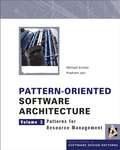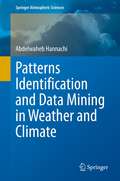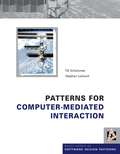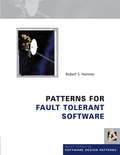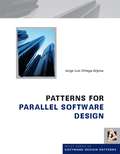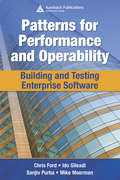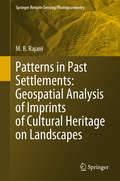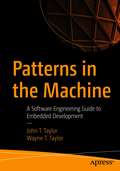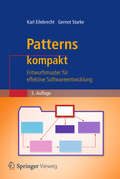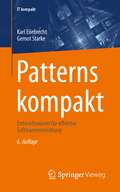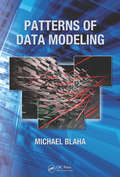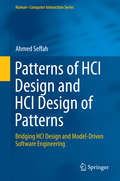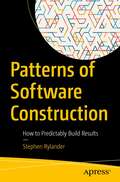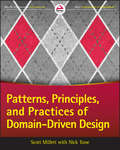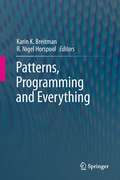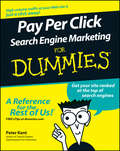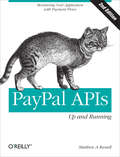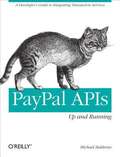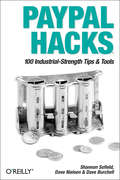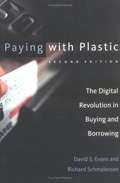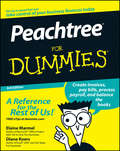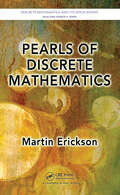- Table View
- List View
Pattern-Oriented Software Architecture, Patterns for Resource Management
by Prashant Jain Michael KircherThe first volume of the POSA pattern series introduced a broad-spectrum of general-purpose patterns in software design and architecture. The second narrowed the focus to fundamental patterns for building sophisticated concurrent and networked software systems and applications. This volume uses design patterns to present techniques for implementing effective resource management in a system.The patterns are covered in detail making use of several examples providing directions to the readers on how to implement the presented patterns. Additionally, the volume presents a thorough introduction into resource management and a case study where the patterns are applied to the domain of mobile radio networks. The patterns are grouped by different areas of resource management and hence address the complete lifecycle of resources: resource acquisition, coordination and release.
Patterns Identification and Data Mining in Weather and Climate (Springer Atmospheric Sciences)
by Abdelwaheb HannachiAdvances in computer power and observing systems has led to the generation and accumulation of large scale weather & climate data begging for exploration and analysis. Pattern Identification and Data Mining in Weather and Climate presents, from different perspectives, most available, novel and conventional, approaches used to analyze multivariate time series in climate science to identify patterns of variability, teleconnections, and reduce dimensionality. The book discusses different methods to identify patterns of spatiotemporal fields. The book also presents machine learning with a particular focus on the main methods used in climate science. Applications to atmospheric and oceanographic data are also presented and discussed in most chapters. To help guide students and beginners in the field of weather & climate data analysis, basic Matlab skeleton codes are given is some chapters, complemented with a list of software links toward the end of the text. A number of technical appendices are also provided, making the text particularly suitable for didactic purposes.The topic of EOFs and associated pattern identification in space-time data sets has gone through an extraordinary fast development, both in terms of new insights and the breadth of applications. We welcome this text by Abdel Hannachi who not only has a deep insight in the field but has himself made several contributions to new developments in the last 15 years. - Huug van den Dool, Climate Prediction Center, NCEP, College Park, MD, U.S.A.Now that weather and climate science is producing ever larger and richer data sets, the topic of pattern extraction and interpretation has become an essential part. This book provides an up to date overview of the latest techniques and developments in this area. - Maarten Ambaum, Department of Meteorology, University of Reading, U.K.This nicely and expertly written book covers a lot of ground, ranging from classical linear pattern identification techniques to more modern machine learning, illustrated with examples from weather & climate science. It will be very valuable both as a tutorial for graduate and postgraduate students and as a reference text for researchers and practitioners in the field. - Frank Kwasniok, College of Engineering, University of Exeter, U.K.
Patterns for Computer-Mediated Interaction
by Stephan Lukosch Till SchummerWritten by well-respected experts, this how-to guide provides patterns for the design of human computer human interaction (HCHI). An increasing number of applications are currently designed for use by more than one user, eg: multi-player games, interactive web sites, mobile phones, collaborative learning systems, interactive workspaces and smart environments. In these areas there is a shift from (HCI) human computer interaction to (HCHI) human computer human interaction. The role of patterns in this movement is twofold: 1st - patterns focus on the human user of the system; 2nd - patterns assist developers in the development process of groupware applications.
Patterns for Fault Tolerant Software
by Robert HanmerSoftware patterns have revolutionized the way developer's and architects think about how software is designed, built and documented.This new title in Wiley's prestigious Series in Software Design Patterns presents proven techniques to achieve patterns for fault tolerant software. This is a key reference for experts seeking to select a technique appropriate for a given system.Readers are guided from concepts and terminology, through common principles and methods, to advanced techniques and practices in the development of software systems. References will provide access points to the key literature, including descriptions of exemplar applications of each technique.Organized into a collection of software techniques, specific techniques can be easily found with sufficient detail to allow appropriate choices for the system being designed.
Patterns for Parallel Software Design
by Jorge Luis Ortega-ArjonaEssential reading to understand patterns for parallel programmingSoftware patterns have revolutionized the way we think about how software is designed, built, and documented, and the design of parallel software requires you to consider other particular design aspects and special skills. From clusters to supercomputers, success heavily depends on the design skills of software developers.Patterns for Parallel Software Design presents a pattern-oriented software architecture approach to parallel software design. This approach is not a design method in the classic sense, but a new way of managing and exploiting existing design knowledge for designing parallel programs. Moreover, such approaches enhance not only build-time properties of parallel systems, but also, and particularly, their run-time properties.Features known solutions in concurrent and distributed programming, applied to the development of parallel programsProvides architectural patterns that describe how to divide an algorithm and/or data to find a suitable partition and link it with a programming structure that allows for such a divisionPresents an architectural point of view and explains the development of parallel softwarePatterns for Parallel Software Design will give you the skills you need to develop parallel software.
Patterns for Performance and Operability: Building and Testing Enterprise Software
by Chris Ford Ido Gileadi Sanjiv Purba Mike MoermanApplications that work perfectly in controlled settings often fail in production environments, impacting business operations. This book explores a frequently overlooked aspect of software development: non-functional design and testing. In the real world, hostile production conditions and changing business usage can lead to unforeseen downtime or unacceptable system performance. Written by technologists and based on real field experience, the book examines common failure scenarios, defensive design patterns, and effective performance strategies.
Patterns in Past Settlements: Geospatial Analysis of Imprints of Cultural Heritage on Landscapes (Springer Remote Sensing/Photogrammetry)
by M.B. RajaniThis book is an introduction to a new branch of archaeology that scrutinises landscapes to find evidence of past human activity. Such evidence can be hard to detect at ground-level, but may be visible in remote sensing (RS) imagery from aerial platforms and satellites. Drawing on examples from around the world as well as from her own research work on archaeological sites in India (including Nalanda, Agra, Srirangapatna, Talakadu, and Mahabalipuram), the author presents a systematic process for integrating this information with historical spatial records such as old maps, paintings, and field surveys using Geographic Information Systems (GIS) to gain new insights into our past. Further, the book highlights several instances where these insights are actionable -- they have been used to identify, understand, conserve, and protect the fragile remnants of our past. This book will be of particular interest not only to researchers in archaeology, history, art history, and allied fields, but to governmental and non-governmental professionals working in cultural heritage protection and conservation.
Patterns in the Machine: A Software Engineering Guide to Embedded Development
by John T. Taylor Wayne T. TaylorDiscover how to apply software engineering patterns to develop more robust firmware faster than traditional embedded development approaches. In the authors’ experience, traditional embedded software projects tend towards monolithic applications that are optimized for their target hardware platforms. This leads to software that is fragile in terms of extensibility and difficult to test without fully integrated software and hardware. Patterns in the Machine focuses on creating loosely coupled implementations that embrace both change and testability. This book illustrates how implementing continuous integration, automated unit testing, platform-independent code, and other best practices that are not typically implemented in the embedded systems world is not just feasible but also practical for today’s embedded projects. After reading this book, you will have a better idea of how to structure your embedded software projects. You will recognize that while writing unit tests, creating simulators, and implementing continuous integration requires time and effort up front, you will be amply rewarded at the end of the project in terms of quality, adaptability, and maintainability of your code. What You Will Learn Incorporate automated unit testing into an embedded projectDesign and build functional simulators for an embedded projectWrite production-quality software when hardware is not availableUse the Data Model architectural pattern to create a highly decoupled design and implementationUnderstand the importance of defining the software architecture before implementation starts and how to do itDiscover why documentation is essential for an embedded projectUse finite state machines in embedded projects Who This Book Is For Mid-level or higher embedded systems (firmware) developers, technical leads, software architects, and development managers.
Patterns kompakt
by Gernot Starke Karl EilebrechtPatterns kompakt fasst die wichtigsten Entwurfsmuster zusammen, die Sie für Software-Entwicklung benötigen. Software-Entwickler, -Architekten und -Designer finden darin effektiv anwendbare Lösungen für tägliche Entwurfsprobleme. Die vierte Auflage wurde um aktuelle Patterns erweitert und komplett überarbeitet. Das Buch gliedert Patterns anhand typischer Aspekte des Software-Entwurfs: Basismuster für mehr Flexibilität und Wartbarkeit, Präsentation, Kommunikation und Verteilung, Integration und Persistenz. Patterns kompakt richtet sich an Praktiker: Software-Entwickler, -Designer, -Architekten und alle, die einen praxisorientierten Überblick zu Entwurfsmustern benötigen.
Patterns kompakt: Entwurfsmuster für effektive Softwareentwicklung (IT kompakt)
by Gernot Starke Karl EilebrechtPatterns kompakt fasst die wichtigsten Entwurfsmuster zusammen, die Sie für Softwareentwicklung benötigen. Softwareentwickler und -architekten finden darin effektiv anwendbare Lösungen für tägliche Entwurfsprobleme. Das Buch gliedert Patterns anhand typischer Aspekte des Softwareentwurfs: - Basismuster für mehr Flexibilität und Wartbarkeit- Präsentation- Kommunikation und Verteilung- Integration- PersistenzDie nunmehr fünfte (aktualisierte und erweiterte) Auflage enthält darüber hinaus ein Kapitel zum Thema Software-Inbetriebnahme.Patterns kompakt richtet sich an Praktiker: Softwareentwickler, -architekten sowie alle, die einen praxisorientierten Überblick zu Entwurfsmustern benötigen.
Patterns kompakt: Entwurfsmuster für effektive Softwareentwicklung (IT kompakt)
by Gernot Starke Karl EilebrechtPatterns kompakt fasst die wichtigsten Entwurfsmuster zusammen, die Sie für Softwareentwicklung benötigen. Sie finden praxisnahe und effektiv anwendbare Lösungen für typische Entwurfsprobleme.Das Buch gliedert Patterns anhand typischer Aspekte des Softwareentwurfs: Basismuster für mehr Flexibilität und WartbarkeitPräsentationKommunikation und VerteilungIntegrationPersistenzDie sechste aktualisierte und erweiterte Auflage erklärt darüber hinaus weitere Musterkategorien.Patterns kompakt unterstützt mit praktischen Tipps zur Softwareentwicklung und -architektur und gibt einen praxisorientierten Überblick zu wesentlichen Entwurfsmustern.
Patterns of Data Modeling
by Michael BlahaBest-selling author and database expert with more than 25 years of experience modeling application and enterprise data, Dr. Michael Blaha provides tried and tested data model patterns, to help readers avoid common modeling mistakes and unnecessary frustration on their way to building effective data models. Unlike the typical methodology book, Patterns of Data Modeling provides advanced techniques for those who have mastered the basics. Recognizing that database representation sets the path for software, determines its flexibility, affects its quality, and influences whether it succeeds or fails, the text focuses on databases rather than programming. It is one of the first books to apply the popular patterns perspective to database systems and data models. It offers practical advice on the core aspects of applications and provides authoritative coverage of mathematical templates, antipatterns, archetypes, identity, canonical models, and relational database design.
Patterns of HCI Design and HCI Design of Patterns
by Ahmed SeffahAs interactive systems are quickly becoming integral to our everyday lives, this book investigates how we can make these systems, from desktop and mobile apps to more wearable and immersive applications, more usable and maintainable by using HCI design patterns. It also examines how we can facilitate the reuse of design practices in the development lifecycle of multi-devices, multi-platforms and multi-contexts user interfaces. Effective design tools are provided for combining HCI design patterns and User Interface (UI) driven engineering to enhance design whilst differentiating between UI and the underlying system features. Several examples are used to demonstrate how HCI design patterns can support this decoupling by providing an architectural framework for pattern-oriented and model-driven engineering of multi-platforms and multi-devices user interfaces. Patterns of HCI Design and HCI Design of Patterns is for students, academics and Industry specialists who are concerned with user interfaces and usability within the software development community.
Patterns of Interaction: Computational Design Across Scales (SpringerBriefs in Architectural Design and Technology)
by Pia Fricker Toni KotnikThis book is a reflection on contemporary computational design thinking at the intersection of architecture, urban design, and landscape architecture, in a time marked by complex challenges like climate change, urbanization and population growth. Based on a critical rethinking of the notion of ground and the relation between the manmade and the natural environment, an understanding of architecture as regenerative practice is proposed. It aims at a built environment as landscape, at an architecture of prosthetic nature. The design approach is illustrated by a number of design experiments conducted within a studio setting and complemented by a series of conversations with leading experts on sustainable design and landscape architecture.
Patterns of Software Construction: How to Predictably Build Results
by Stephen RylanderMaster how to implement a repeatable software construction system. This book closely examines how a system is designed to tie a series of activities together that are needed when building software-intensive systems. Software construction and operations don't get enough attention as a repeatable system. The world is stuck in agile backlog grooming sessions, and quality is not increasing. Companies' budgets are shrinking, and teams need a way to get more done with less, consistently. This topic is very relevant to our current economic conditions and continuing globalization trends. A reason we constantly need more hands-on-the-keyboards is because of all the waste created in development cycles. We need more literature on how to "do software" not just write software. These goals are accomplished using the concept of evolutions, much like the Navy SEALS train their team members. For LIFT, the evolutions are: Plan, Build, Test, Release, Operate and Manage. The entire purpose of the book is instructing professionals how to use these distinct evolutions while remaining agile. And then, inside of each evolution, to explicitly break down the inputs to the evolution, outputs and series of activities taking place. Patterns of Software Construction clearly outlines how together this becomes the system.What You Will LearnOptimize each evolution of a software delivery cycleReview best practices of planning, highest return in the build cycle, and ignored practices in test, release, and operate Apply the highest return techniques during the software build evolutionWho This Book is ForManagers, developers, tech lead, team lead, aspiring engineer, department leaders in corporations, executives, small business owner, IT Director
Patterns, Principles, and Practices of Domain-Driven Design
by Scott Millett Nick Tuneof concept in action that other books have only covered theoreticallyCovers the patterns of CQRS, Messaging, REST, Event Sourcing and Event-Driven ArchitecturesAlso ideal for Java developers who want to better understand the implementation of DDD
Patterns, Programming and Everything
by Karin K. Breitman R. Nigel HorspoolWith 11 invited submissions from leading researchers and teams of researchers sharing one common characteristic ? all have worked with Dr. Judith Bishop during her long and continuing career as a leader in computer science education and research ? this book reflects on Dr Bishop?s outstanding contribution to computer science. Having worked at three different universities she now holds a leadership position in the research division of a major software company. The topics covered reflect some of the transitions in her career. The dominant theme is programming languages, with chapters on object oriented programming, real-time programming, component programming and design patterns. Another major and related topic is compilers, with contributions on dataflow analysis, tree rewriting and keyword recognition. Finally, there are some additional chapters on other varied but highly interesting topics including smart homes, mobile systems and teaching computer science.
Pay Per Click Search Engine Marketing For Dummies
by Peter KentPlan and launch your PPC campaign and keep track of its progress If you want potential customers to form a traffic jam at your Web site, Pay Per Click just might do the trick. This book will help you decide! It tells you all about Google AdWords and Yahoo! Sponsored Search, targeting your customers, watching out for fraud, assessing the pros and cons of Pay Per Click, and making Pay Per Click work for you. Discover how to Use the right keywords to trigger your ads Figure your breakeven point Write ads that reach your customers Calculate return on investment Use geo targeting Track your ad results
PayPal APIs: Monetizing Your Application with Payment Flows
by Matthew A. RussellIf your web application’s success depends on how quickly and easily users can make transactions, PayPal APIs provide effective solutions you can’t afford to overlook. This concise book takes you hands-on through several options to help you determine the best choice for your situation, whether you’re collecting money via websites or mobile apps for products and services, donations, or anything else.In each chapter, you’ll work with a different PayPal API by integrating it into the book’s sample application, using Python and the Google App Engine framework. This expanded edition introduces two new options: Express Checkout for Digital Goods and Instant Payment Notifications, complete with sample project code. By the end of this book, you’ll understand how to take full advantage of PayPal and its powerful features.Learn PayPal API basics, and get an introduction to Google App EngineExplore the Express Checkout option, and understand what distinguishes it from other generic workflowsTailor Express Checkout for electronic documents, videos, and other “in app” digital purchasesApply the Adaptive Payments option for transactions that involve multiple recipientsEmbed the payment process into your site with no mention of PayPal, using Website Payments ProUse the Instant Payment Notifications you receive as triggers to take follow-up action
PayPal APIs: Up and Running
by Michael BalderasIf your web application's success depends on how quickly and easily users can make transactions, then PayPal is a solution you can't afford to overlook. This book helps you determine which PayPal option is best for your situation, and provides step-by-step instructions for implementing the payment method you choose--whether you're accepting money via the Web or mobile devices for products and services, donations, or anything else. You'll find sample code written primarily in PHP and Objective-C, as well as use cases for executing options with PayPal's API. By the end of this book, you'll have a clear understanding of PayPal and how you can get the most out of its powerful features, no matter how much API programming experience you have. Learn how to work with the PayPal API, and choose the right integration method for your project Explore PayPal's Express Checkout option, including its unique workflow and four methods of operation Examine the Website Payment Pro method--with a focus on direct payments Consider Adaptive Payments and learn how to set permission levels for their use Use PayPal in your iOS or Android-based mobile app with the new Mobile Express Checkout method Test your PayPal implementation with the sandbox
PayPal Hacks: 100 Industrial-Strength Tips & Tools (Hacks)
by Shannon Sofield Dave Nielsen Dave BurchellIf you've bought or sold items through eBay, or through hundreds of other online sites, then you're familiar with PayPal, the online payment service. With PayPal, a valid email address, and a credit card or bank account, you can easily send and receive payments online. Not a bank or financial institution itself, PayPal describes its service as one that builds on the financial infrastructure of bank accounts and credit cards, and using advanced propriety fraud prevention systems, creates a safe, global, real-time payment solution. Put simply, PayPal provides the means for people to conduct financial transactions online, instantly and securely.But there's more to PayPal than meets the eye. PayPal Hacks shows you how to make the most of PayPal to get the most out of your online business or transactions. Authors Shannon Sofield of Payloadz.com and PayPal evangelist David Nielsen guide you through the rigors of using and developing with PayPal. Whether you're building an ecommerce site using PayPal as a transaction provider, or simply trying to pay for an eBay auction without getting burned, PayPal Hacks will give you the skinny on this leading global online payment service.The collection of tips and tricks in PayPal Hacks shows you how to find or even build the right tools for using PayPal to buy and sell on eBay or as a transaction provider for ecommerce on your own site. Written for all PayPal users, from those just starting out to those developing sophisticated ecommerce sites, this book begins with the basics such as setting up your account, then moves quickly into specific tips and tools for buyers, sellers, and developers.With PayPal Hacks, you can:Learn extra steps to help protect yourself while buying or selling on eBaySave time and money with advanced tips and undocumented featuresLearn dozens of easy-to-follow procedures to help you request and receive payments and fill ordersUse PayPal to handle subscriptions, affiliate systems, and donationsCreate and customize your customers' checkout processEffortlessly integrate PayPal's shopping cart system into your own websiteImplement digital fulfillment with Instant Payment Notification (IPN) and Payment Data Transfer (PDT)Develop and distribute ecommerce applications with the PayPal APIEach hack consists of a task to be accomplished or a creative solution to a problem, presented in a clear, logical, and task-oriented format. PayPal Hacks provides the tools and details necessary to make PayPal more profitable, more flexible, and more convenient.
Payara Micro Revealed: Cloud-Native Application Development with Java
by David R. HeffelfingerDevelop, configure, and deploy Java cloud-native applications using Payara Micro. This book demystifies Java cloud-native application development using standard Microprofile APIs and covers Payara-specific features such as automatic clustering and application initialization performance improvements. You will learn how to improve startup performance by taking advantage of class data sharing, and configure cloud-native applications via standard development tools such as Maven and Gradle. The book also clarifies how to develop functionality necessary in a cloud environment, such as health checks and request tracing, using MicroProfile APIs. The book begins by showing how to develop microservices using RESTful web services, followed by how to create microservice clients using MicroProfile and the REST client API. Dependency Injection via Jakarta Context and Dependency Injection (CDI) is also covered. Various approaches to application configuration are covered as well, including property files, environment variables, and system properties. You will learn to configure fault tolerance and high availability, generate system and custom application metrics, and generate health checks to automatically improve overall application health. You will know how to trace the flow of a request across service boundaries with OpenTracing. You will be able to make future maintenance easily through generating documentation, including how to automatically update documentation as your code is updated. Additionally, you will learn how to secure cloud applications and to automatically cluster applications and improve application startup performance.What You Will LearnDevelop microservices using standard Java APIsImplement cloud functionality such as request tracing and health checksDeploy applications as thin archives and as uber archivesConfigure applications via Maven and GradleGenerate custom metrics for capacity planning and proactive discovery of issuesImplement features in support of high availability and fault toleranceSecure your applications with Jason Web TokensTake advantage of Payara’s own cloud platform for easy deploymentWho This Book Is ForJava developers who wish to develop cloud-native applications and microservices, and Java EE application developers who wish to transition to developing cloud-native applications that are lightweight and easily deployed
Paying with Plastic: The Digital Revolution in Buying and Borrowing
by David Evans Richard SchmalenseeThe payment card business has evolved from its inception in the 1950s as a way to handle payment for expense-account lunches (Diners Club card) into today's complex, sprawling industry that drives trillions of dollars in transaction volume each year.
Peachtree For Dummies
by Elaine Marmel Diane KoersNot feeling too peachy about computerizing your accounting system? Relax! Peachtree For Dummies, 3rd Edition will show you how to set up your company in Peachtree and then use it to pay bills, invoice customers, pay employees, produce financial reports, and more. You'll quickly discover how Peachtree can save you time, effort, and money so that you no longer have to do your accounting by hand or pay someone else to do it for you.Publishing to coincide with the latest release of Peachtree, this third edition is revised to cover the newest updates and enhancements made to the most recent version of Peachtree. Veteran authors Elaine Marmel and Diane Koers break down the capabilities of Peachtree Premium Accounting, from building an effective chart of accounts, to customizing forms and modifying reports, to setting up default information that will save you time down the line. You'll also discover how to:Work with purchase ordersSell products and servicesGenerate invoicesTrack project costsProduce income statementsBack up and restore dataBalance accountsManage inventoryHandle customer prepaymentsPay for purchase orders with a credit cardKeep your account information safePacked with examples of everyday, real-life situations, Peachtree For Dummies, 3rd Edition is the reference you need so that you can put Peachtree to work for you and get the job done quickly and correctly.
Pearls of Discrete Mathematics (Discrete Mathematics and Its Applications)
by Martin EricksonMethods Used to Solve Discrete Math ProblemsInteresting examples highlight the interdisciplinary nature of this areaPearls of Discrete Mathematics presents methods for solving counting problems and other types of problems that involve discrete structures. Through intriguing examples, problems, theorems, and proofs, the book illustrates the relation
